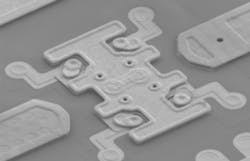DelfMEMS RF-MEMS switch exceeds 1 billion operations
Villeneuve d’Ascq, France. DelfMEMS, a developer of innovative RF MEMS switching products, has announced that its 12-throw, RF-MEMS ohmic contact switch design has just passed the 1-billion-test-cycle milestone and is still going strong.
Cybele Rolland, DelfMEMS CEO, explained, “Achieving the billion switch milestone is a major achievement for our FreeFlex design. Importantly, this is the first time an industrialized RF-MEMS contact switch has been shown to achieve this level of performance, but this is only the beginning. Our second-generation production switches, which we will be shipping towards the end of 2016, are expected to achieve up to 50 billion operations. This ensures that they will reliably deliver the performances required for the next generation of handsets, LTE-A and beyond, with ultra-low insertion loss, outstanding isolation, and superior linearity, which for end users translates to longer battery life, better call quality and massively increased data speeds.”
There are key two innovations by DelfMEMS that help it achieve this breakthrough. First, although gold is currently used as the contact material, this will be replaced in the production switches by a metal compound that has been proven to be reliable for cold switching in excess of 50 billion cycles. Second, its patented FreeFlex MEMS switch design ensures that the contact point is always changing slightly, which lengthens the life of the switch.
The DelfMEMS RF-MEMS switch structure uses a new, integrated, micromechanical building block that is based on a robust, new IP portfolio that includes seven key patents and innovations. It does not use a cantilever beam or bridge featuring a highly conductive electrode electrostatically actuated in order to create an ohmic contact resulting in a mechanical switching. These older structures proved to have several issues: stress on the anchors, possible stiction, low commutation speed, and possible creep of the beam.
DelfMEMS innovative design approach has resulted in the development of an anchorless structure for mechanical RF switching that overcomes these historical design problems instead of trying to simply reduce them.
The FreeFlex membrane is always in a known controlled state as it is electrostatically actuated by two sets of electrodes. The electrostatically ON state is achieved by making physical contact between the membrane contact area and the transmission line, and the similarly controlled OFF state is achieved by keeping a physical distance between the membrane contact area and the transmission line. This means that the switch contact area will either be attracted to the conductive line or repelled from it. Moving from ON state to OFF state is made through an electrostatic active actuation, which de-couples between restoring forces, contact forces and the membrane mechanical properties
Another advantage of FreeFlex switch structure is the possibility to have a reduced gap between the membrane and the transmission line, which will reduce the creep and mechanical stress by lowering the maximum deflection of the membrane. This results in an increased contact force in ON-state with lowered actuation voltage and therefore lower insertion losses.
DelfMEMS RF-MEMS switches are surface micromachined devices that use a mechanical movement to switch the RF transmission line on or off. This technology does not suffer from frequency dependency and high multi-throw switch configuration limitation. With a figure of merit <10, it offers dramatically superior linearity, insertion loss, and isolation performance compared to existing solid-state solutions. This first generation of DelfMEMS switches are manufactured by Honeywell/Tronics in Dallas, TX, and will complete qualification by the end of 2015.
About the Author

Rick Nelson
Contributing Editor
Rick is currently Contributing Technical Editor. He was Executive Editor for EE in 2011-2018. Previously he served on several publications, including EDN and Vision Systems Design, and has received awards for signed editorials from the American Society of Business Publication Editors. He began as a design engineer at General Electric and Litton Industries and earned a BSEE degree from Penn State.



